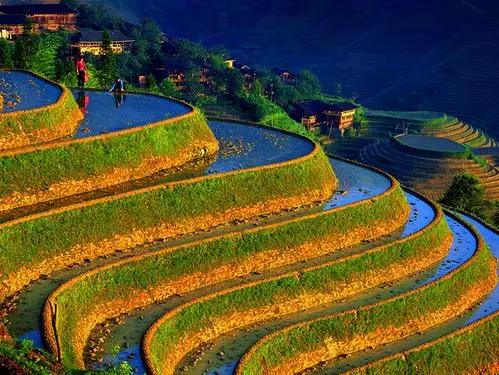March 26, 2010
This excerpt is part of a larger feature I wrote that was published by The Atlantic in November 2009. To read the introduction and access descriptions of the other eight “nations” of China, click here.

SHANGRI-LA(Yunnan, Guizhou, Guangxi)
Territory: 810,690 km2 (8% of total)
Population: 132 million (10% of total) * 30% non-Han minorities
Per Capita GDP: $1,770 (#9 of 9)
Exports as % of GDP: 6%Net Trade Balance (ex-China): <$1 billion surplus
The legend of Shangri-La tells of an isolated valley high in the Himalayas, where paradise exists on earth. Local tourism officials claim to have located the real Shangri-La in southwest China, and millions of visitors every year seem to agree. This land is home to some of China’s most iconic and inspiring landscapes: emerald rice terraces, the fairy mountains of Guilin, the raging rapids of Tiger Leaping Gorge. It’s also home to a kaleidoscope of ethnic minorities, usually depicted as singing and dancing in colorful tribal costumes. Throw in a clear blue sky and some banana pancakes, and Shangri-La makes for a heavenly vacation.

Behind the postcard-perfect images, however, lies a darker reality. Cut off from the outside world by jagged mountains and primitive infrastructure, Shangri-La is the poorest of the Nine Nations. Before the Revolution, the region’s main cash crop was opium. Its replacement, tobacco, turned Shangri-La into the main supplier for China’s latest deadly addiction: cigarettes. Meanwhile, Shangri-La still borders Burma’s infamous Golden Triangle, making it China’s primary gateway for illicit drugs and the accompanying spread of HIV/AIDS, which the region’s overburdened health care system is unequipped to handle. The other mainstays of the local economy—logging, strip mining, and land-intensive crops such as sugarcane and rubber—have taken a heavy toll on the environment. All in all, hardly an image of paradise.

Despite these grave problems, Shangri-La possesses untapped resources. Its forests are home to over half of China’s birds and mammals, as well as thousands of rare plant species, some of which may hold the key to new medicines. The region’s lush hills and valleys—the original birthplace of tea—offer ideal conditions for growing tropical fruits, coffee, and flowers. The great lifelines of East Asia—the Yangtze, Salween, Irrawaddy, Mekong, and Red Rivers—all originate in Shangri-La, ensuring a plentiful supply of water for consumption and hydropower. New transport links are being built to expand China’s burgeoning trade with its ASEAN neighbors. None of these opportunities comes without challenges. But for long-suffering Shangri-La, each step closer to heaven is one step farther from hell.

Leave a Reply